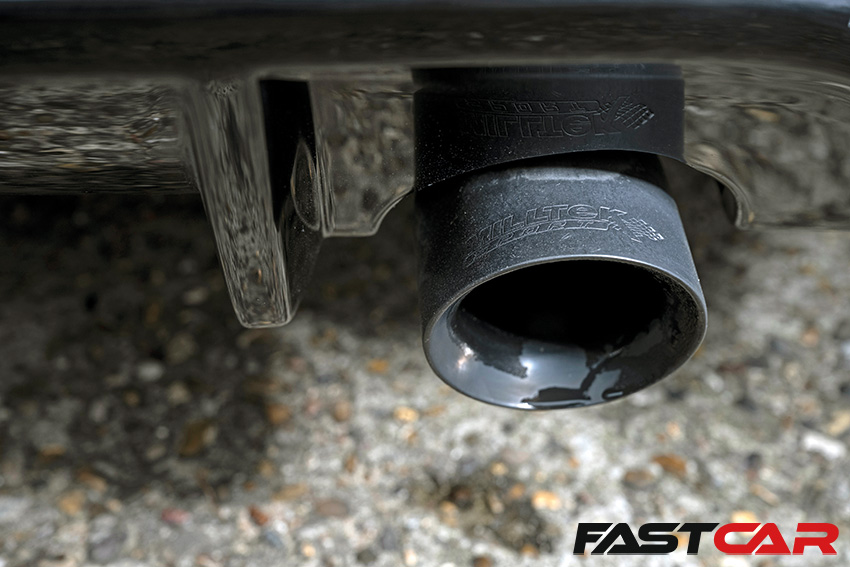Want to learn about car exhaust systems? This exhaust guide will give you all the introductory info (and some more technical knowledge!) that you need.
Exhausts aren’t quite as simple as the may seem on the surface, so if you need to get up to speed on how they work and how they affect your car’s performance, look no further. Here’s our beginner’s exhaust guide!
Why Change your car exhaust?
Apart from the obvious fact that a nice shiny stainless system looks and sounds better than standard, a performance exhaust is there to get your engine breathing more effectively, it’s that simple. Engine tuning is all about flowing gasses quickly and efficiently. To make more power you need extra air in (so you can bung in more fuel) and get those increased exhaust gasses out as fast as possible – the latter is where your exhaust system comes in. A performance system is designed to flow better than standard, helping to draw more air through the head. Getting rid of standard restrictions helps you gain more power – and that’s the name of the game.

Car exhaust system variations
Because of their shape, all exhausts systems are vehicle specific; you can’t just buy a load of pipe and gaffer tape your own together, it just wouldn’t work. That said, whether you go for a custom made or off-the-shelf item, the basics are the same – most exhausts come in sections, and it’s all about upgrading the component parts of the system.
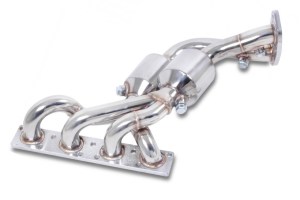
Exhaust manifold / header
A manifold, or header, is the part that takes the exhaust gasses from the cylinder outlets on through to the rest of the system. Typically there will be an individual ‘head pipe’ flange (or ‘runner’) for each cylinder and these will join together to form the ‘collector’– a single outlet which goes on to the exhaust or turbo.
Your engine will dictate the makeup and how many manifolds you need. Typically in-line and boxer engines have a single exhaust bank (all their exhaust ports in the same place on the same side, or on the bottom of the cylinder head) so will need one manifold. A V-configuration or W-configuration engine will have multiple exhaust banks so will need a manifold for each. The manifold is also where you’ll usually find the turbocharger.
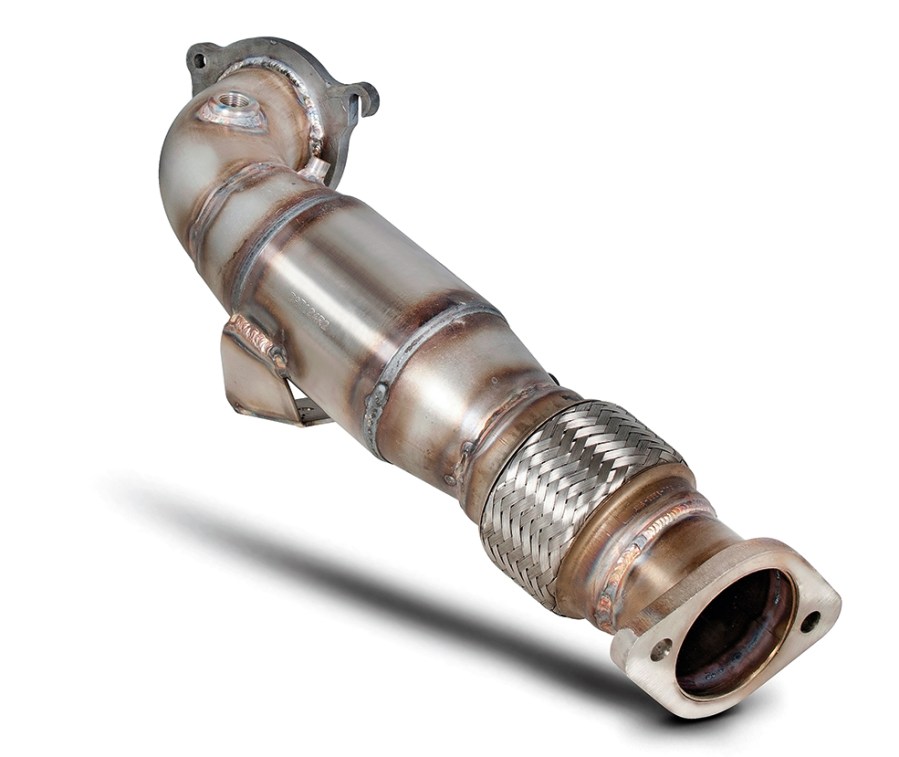
Catalytic converter
The cat is an emissions control device which, basically speaking, is made up of a high-surface-area, honeycomb core containing a catalyst. The catalyst is generally a mixture of precious metals like platinum. It’s the job of the catalyst to promote a reaction between carbon monoxide (CO) and unburned hydrocarbons (HC) to produce water (H2O) and carbon dioxide (CO2). They also reduce nitrogen oxides. In other words they don’t actually reduce emissions, they make harmful emissions into less harmful emissions.
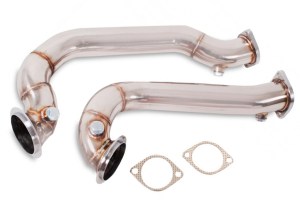
Car exhaust downpipe
Generally (all cars are different after all) a downpipe will direct the gasses down from the manifold (or turbo outlet) to the cat. As standard, these can be restrictive and a popular target for replacement – it’s not uncommon to see 30bhp+ power gain simply by fitting a high-flow item on a turbo car.
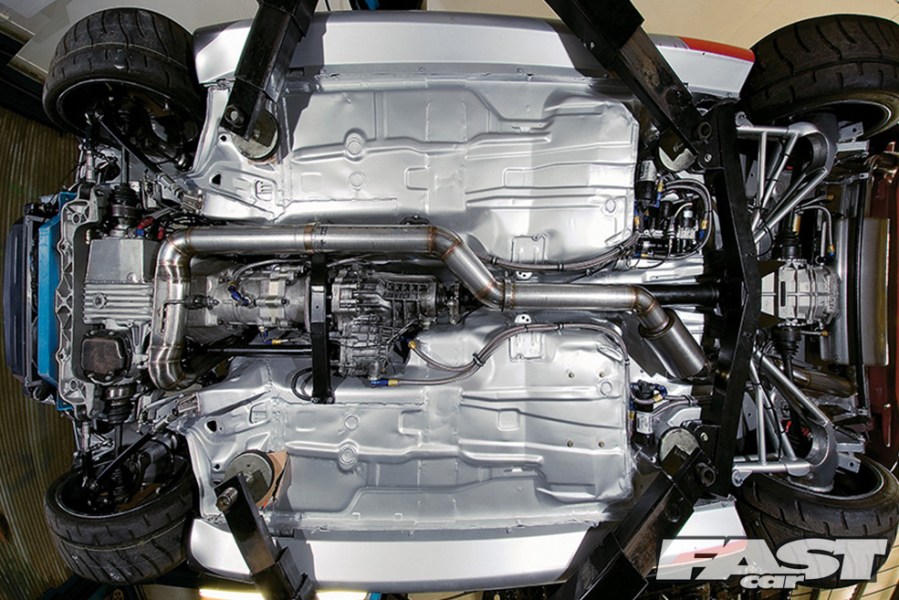
Center pipe
On most cars the center section is a simple piece of pipe bent to pass under the car, joining the backbox to the front of the system. This can contain resonators and silencers or even the cat, and will usually be the place where you’ll find the lambda sensor, which monitors exhaust gasses.
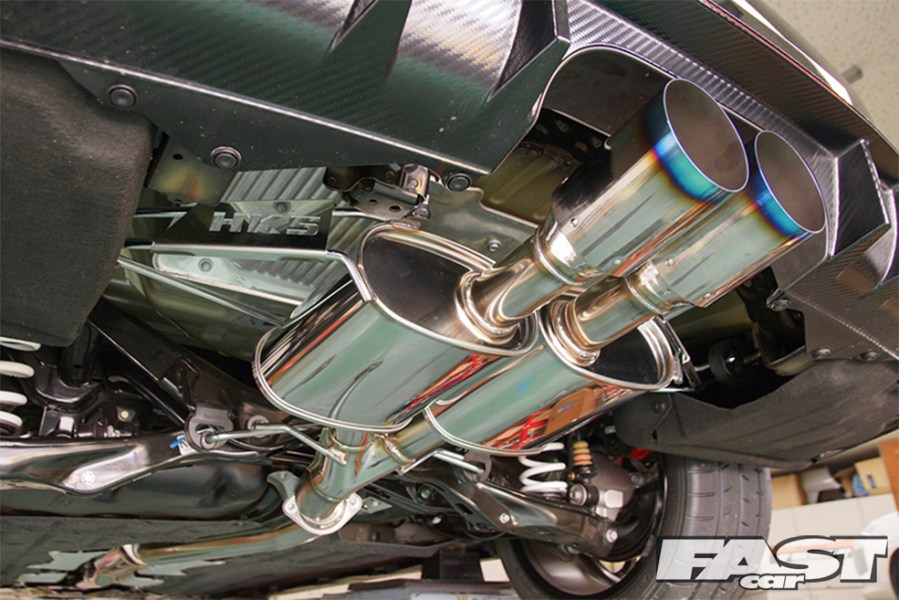
Silencer / Muffler
The silencers (or mufflers) in the system are sound proofing devices designed to reduce the volume of the sound pressure created by the exhaust gasses. They contain a series of restrictive passages lined with fibreglass insulation, designed to baffle the sound as the gasses pass through.
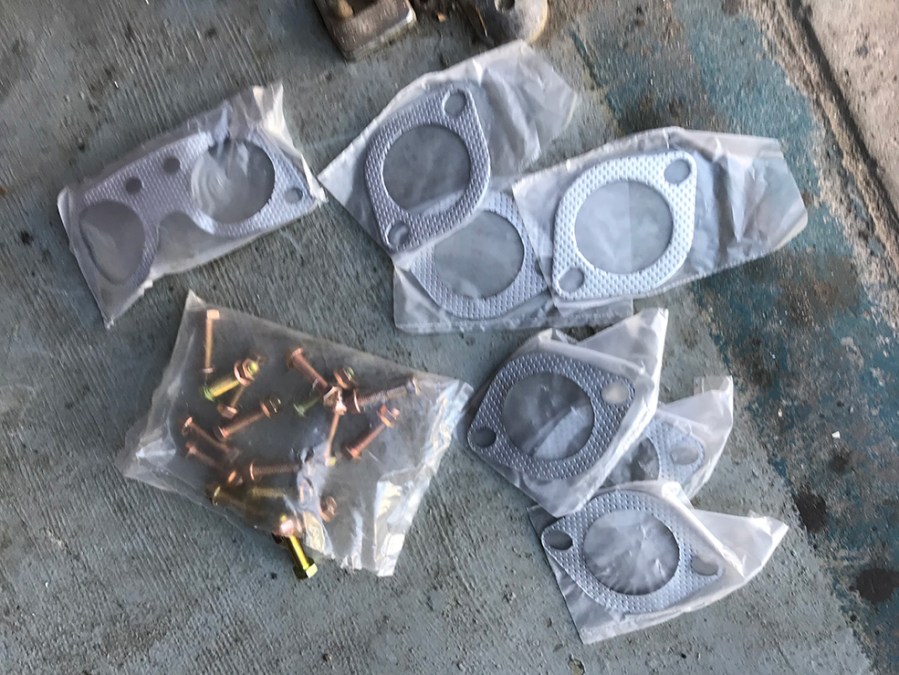
Flanges
As most exhausts come in sections, it makes sense that each will need a flange to bolt it to the next – there will be a soft gasket between each join to prevent leaks too.
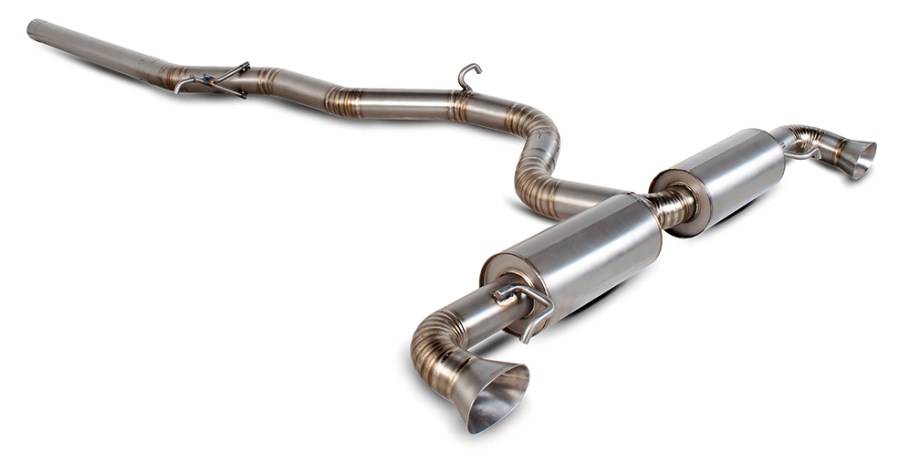
Car exhaust resonators
Although these are more often found in aftermarket systems, particularly downpipes and center pipes, some standard items will run resonators. This is a part of the system that is expanded to a bigger diameter. The idea is to disturb the flow, bouncing sound waves off one another, cancelling them out and making the system slightly quieter. These produce much less backpressure than silencers.
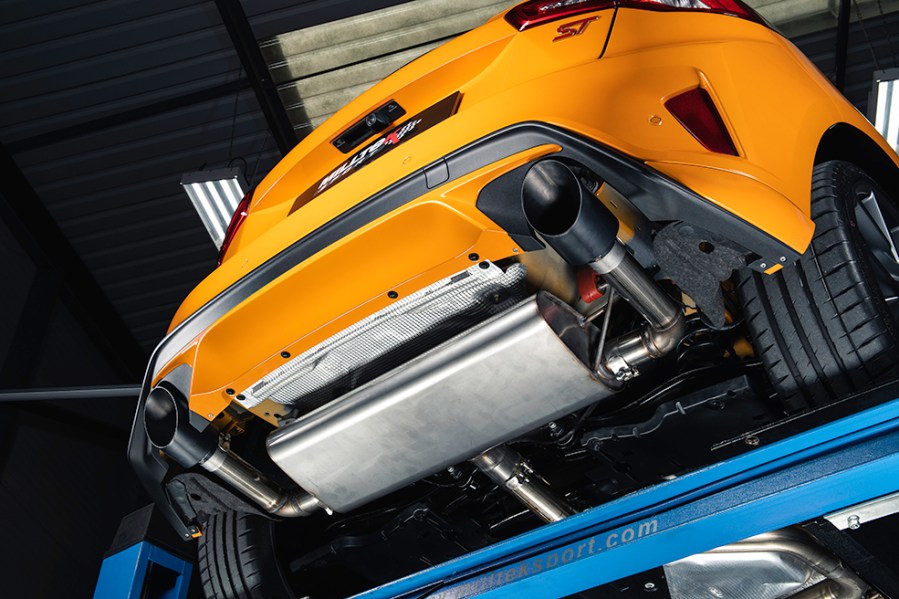
Back Box
As the name suggests this is quite literally the ‘back box.’ Most of the time it’s basically a big, fat silencer. More importantly though, it’s attached to the nice, shiny tail pipes.
From a modifying perspective, if you’re on a budget, a specific-fit uprated backbox can be a good choice. It’s true, you’ll only see a very mild performance gain because they’re designed to be slightly less restrictive than stock but, you’ll get a nice shiny tailpipe and a throatier noise. After all, it’s the only bit you can actually see – so if you’re not fussed about power, it’s always a winner.
Unlike the rest of your system, there are also a few universal items on the market which seem universally designed to fit bugger all. Unless you’re a competent welder or willing to get a pro to install it, you’ll never get it fitting right. We’d recommend steering clear and paying the extra few quid for one that fits first time.
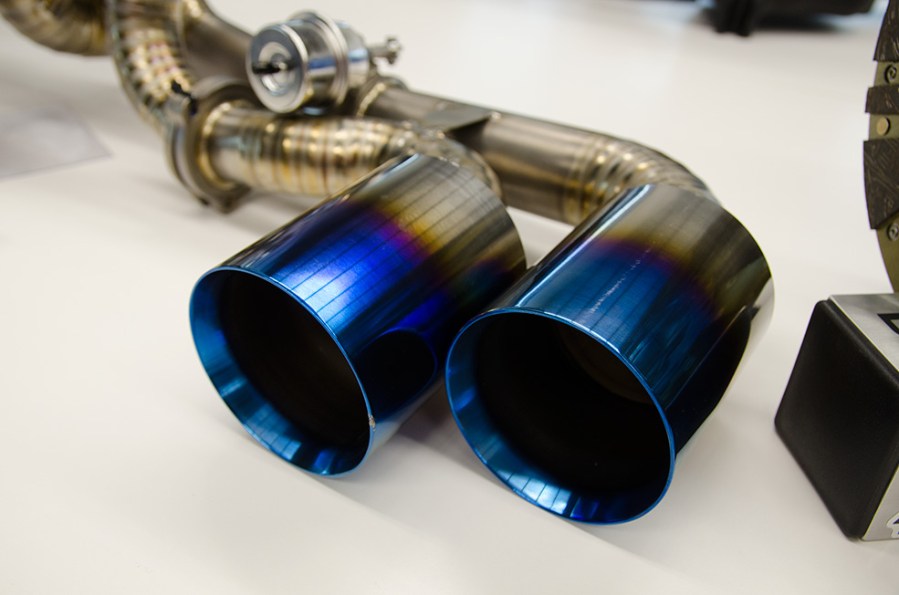
Car exhaust materials
Some high-end manufactures will use stainless steel right off the bat but, for the most part, standard systems are made from mild steel which, while pretty resilient to knocks and scrapes, is cheap and rusts like a bugger over time.
Most aftermarket exhausts are made from high-quality stainless steel which is much lighter, doesn’t rust and will usually last longer than the life of the car. There are of course more exotic options too. Full titanium exhausts are ridiculously light, and some exhausts have some seriously trick carbon components too. It all depends on what you can get for your specific fitment and, of course, how deep your pockets are.

Back pressure = the enemy
In the performance stakes, the thing to remember is that better flow (and therefore straighter pipe design) is everything, and less back-pressure – generally – means more power. Technically back-pressure is the force opposed to the desired flow of a liquid or gas in a confined space. It’s a misleading term, because it implies that it’s a flow in the opposite direction, when in reality it’s just resistance created by other influences (like pipe diameters and the amount of bends) causing a reduced flow.

Car exhaust noise
Quite obviously, as the resistance decreases, the noise goes up – there’s a reason they call those restrictive boxes silencers! For flow purposes, having no silencers or resonators at all would be best but, don’t forget, you’re the one who has to live with it. Take it from experience, sitting on the motorway at 3-4000rpm with a loud exhaust can really do your head in, we’ve made these mistakes so you don’t have to! You may think a stupidly loud exhaust okay for track-days but, that’s not the case either. Most tracks place noise restrictions on cars and you will be tested before being allowed on the circuit. It’s a trade off between optimum performance, and actually wanting to drive it.
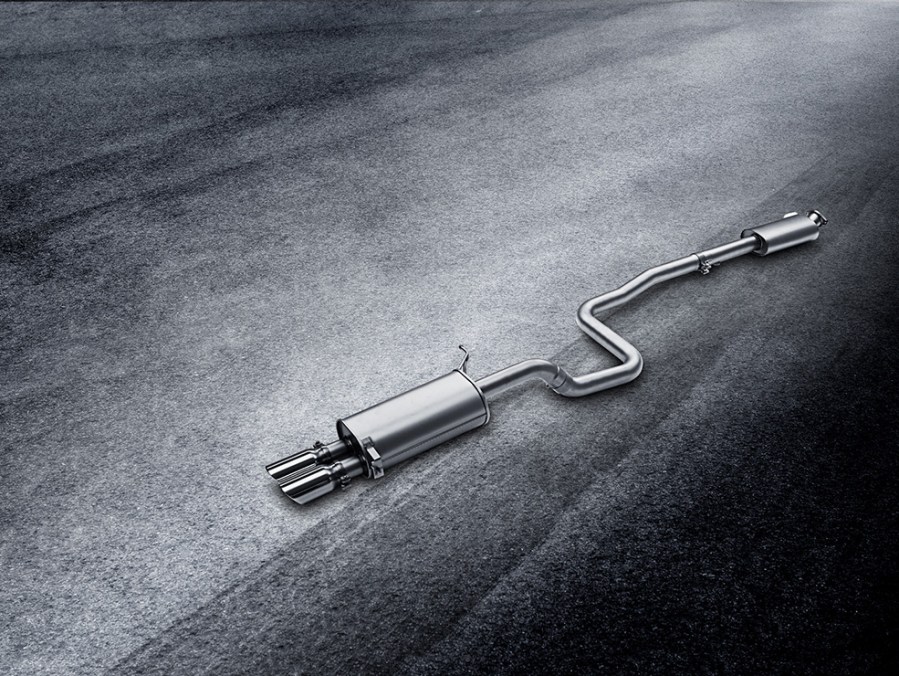
Bendy shapes
In an ideal world, exhausts would be a straight pipe, front to back, with no bends – unfortunately this is rarely possible. It’s still something to bear in mind though, performance systems are designed to be as free from contortions as possible, often re-routing the standard location for optimum flow. It’s also advisable to look out for quality workmanship in the bends – all good systems will be ‘mandrel bent’ on a special machine meaning the tube will hardly change diameter through the twisty stuff. This prevents any ‘pinching’ in the pipe which will cut down the potential airflow.
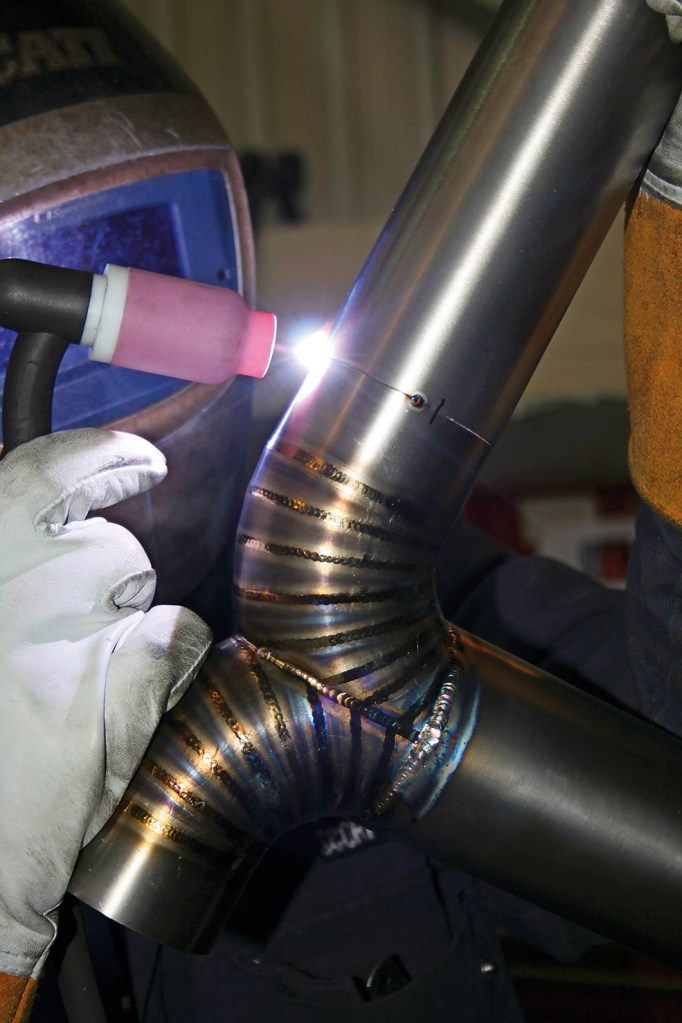
Welding
While you’re looking for quality workmanship, it’s worth checking out the welds. Obviously you’re after nice neat jobs and not a blotchy, splotchy mess. Most exhaust will be MIG (metal inert gas) or, better still, TIG (tungsten inert gas) welded for a strong permanent seal. Some posh units are also ‘back-purged’ shielding the inside of the weld to prevent oxidation as well as the outside. It takes skill and experience to get these spot on (or sometimes robots) but remember smooth and sexy on the outside usually means smooth on the inside and less disturbances in the gas flow.
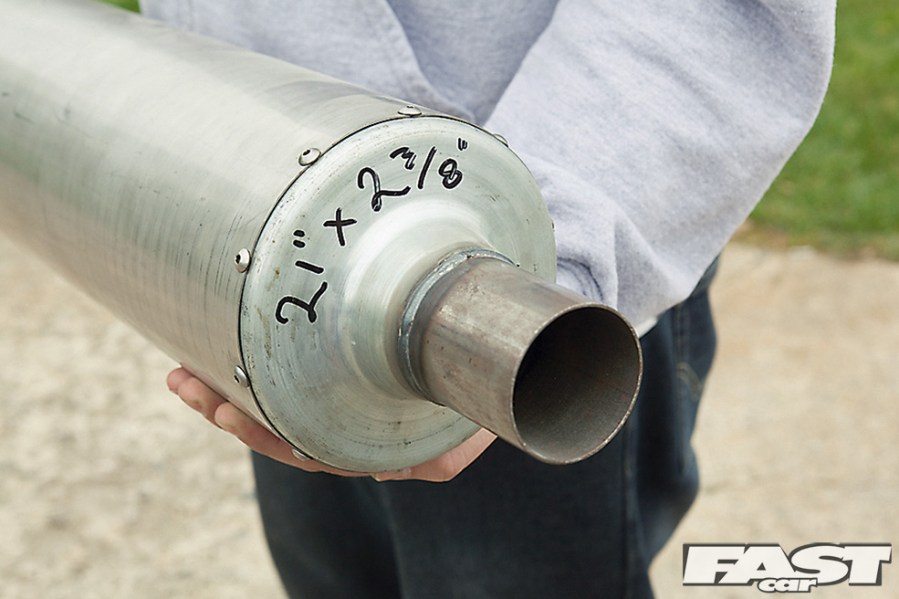
Car exhaust bore size
You’ll find that aftermarket systems will usually be a larger diameter than standard, cutting down massively on back-pressure, so you’d think the bigger you can go the better. Unfortunately it’s not that simple. Smaller-diameter pipes, while more restrictive, do mean higher gas speeds, which help the scavenging effect needed on normally aspirated cars. It’s a complicated scientific process dealing with high and low atmospheric and internal pressures but basically you’ll notice the gas pulsing when it exits the pipe helping to suck the following gas out far faster than it would naturally. It’s this that makes designing n/a exhausts a balancing act between a bigger, less-restrictive diameter pipe and something that’ll have the desired scavenging effect.
For turbocharged lumps it’s much simpler; larger diameters are the king, because there’s less resistance slowing the spinning compressor wheels. For supercharged engines, which need a little scavenging while off boost, it’s somewhere in between.
It always makes sense to seek advice for the best size for your particular application. Luckily, with plenty of off-the shelf units available they’ve already done the research for you. As a rule of thumb though, for up to 300bhp a 2.5-inch bore is normally more than sufficient. Up that to 3-inches if you’re looking at 500bhp and a whopping 5-inches if you’re building something with bollocks the size of planets.

Heat management
Exhausts work better when they’re hot simply because warmer gasses move faster; if you’ve ever had a mutton vindaloo, you’ll already know that. With that in mind there are a few aftermarket processes that help keep the heat inside exactly where you want it. Most commonly, you’ll see heat-wrap – an inexpensive thermal bandage that’s wrapped around as much of the system as possible. Then there’s high-end ceramic coatings that do an impeccable job, that’s more than reflected in the price. Keeping the heat in the pipes not only promotes faster gas flow but, it helps keep engine bay temperatures down, meaning less induction heat-soak and yet more power.

The Law and an aftermarket car exhaust
There are loads of things to consider when deciding what sort of upgrade you’re looking for but, perhaps the first is the simplest: do you want to drive your car on the road? Contrary to popular belief in the UK, there’s no maximum noise limit for exhausts on production cars (that’s reserved for kit cars and motorbikes) but, technically, it is an offence to modify your exhaust to be louder than standard, so don’t go too mental. If the gentlemen at the local constabulary can prove that yours is louder than it should be, you’ll be made to sort it out or face a hefty fine. If you’re sensible, though, it’s unlikely that you’ll get a tug, after all it’s hard to definitively measure just how loud every standard exhaust out there is and then test every modified car, not to mention a lot of paperwork.
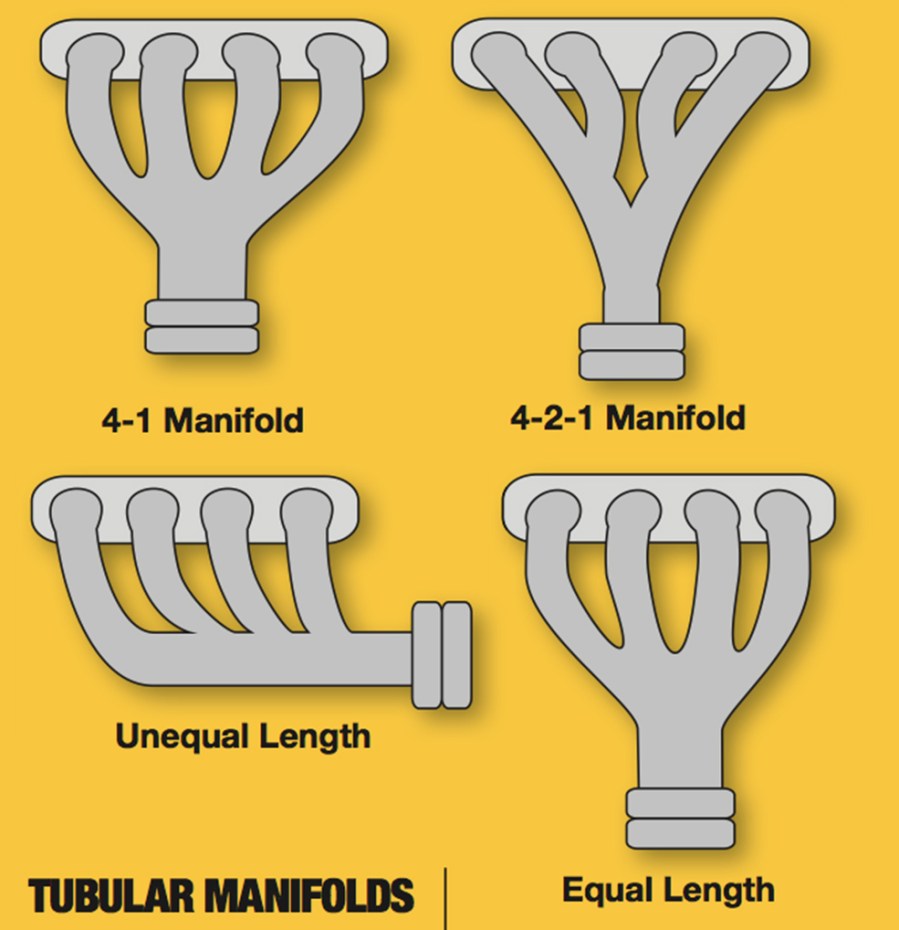
Tubular manifolds
Standard manifolds on most cars are made of cast iron, and are not only notoriously restrictive but, pretty bloody heavy too. Most don’t have equal length runners (singular header pipes) either. A tubular manifold will not only smooth out the gas flow and offer less restriction, but most come with equal length runners which can give an advantage in performance and engine life.
It might not sound important but, it’s all down to the science – equal length runners are designed keep exhaust gas temperatures equal in each cylinder which can be essential for the health of your lump – especially when running big-power. Having longer runners on some cylinders creates higher temperatures because the hot gas will stay in those particular pipes for more time. Makes sense.
On some cars they drastically change the sound too, smoothing out any pulses and rumbles. With equal length headers, the distinctive boxer engine sound, made famous by Subaru, has a distinctly different note, more akin to a normal in-line 4-cylinder. For this reason it’s always a debate whether to swap for hardcore Subaru fans.
Manifolds also have other performance characteristics due to their construction. 4-2-1 manifolds will go from 4 runners to 2 and then on to the single collector where, as the name suggests, 4-1 units will go straight from 4 to 1. The key is to do your research as to what’s best for you.
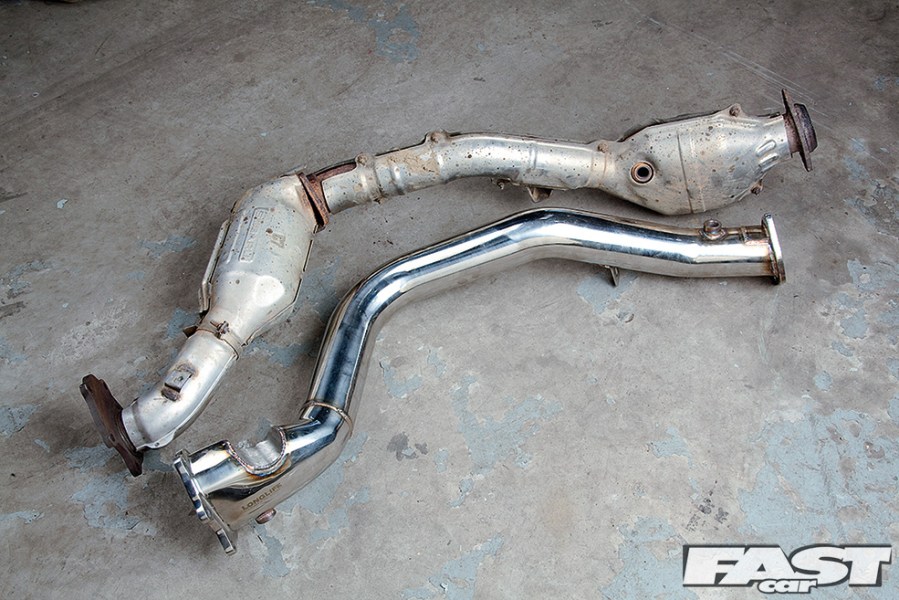
Ditching the cat from your car exhaust?
Legally, to cat or not to cat, is probably the biggest dilemma in tuning. Being the most restrictive part of the system, dumping it can see big gains. But, the downside is all petrol cars since around 1992 (1994 for imports) need one to get through emissions tests. So do you choose a ‘cat-back’, with your new system starting after the cat or, a manifold/ turbo-back setup, ditching the cat for, ahem, ‘race use’ only?
Of course, there’s also the option of a sports cat, which is less restrictive but still emissions friendly or, a de-cat pipe which you can swap for your catalyst when you’re off the track. Some people even hollow out their stock cat or weld a straight pipe through the middle to fool inspections. We’re not condoning it but we’ll give it an A* for effort!
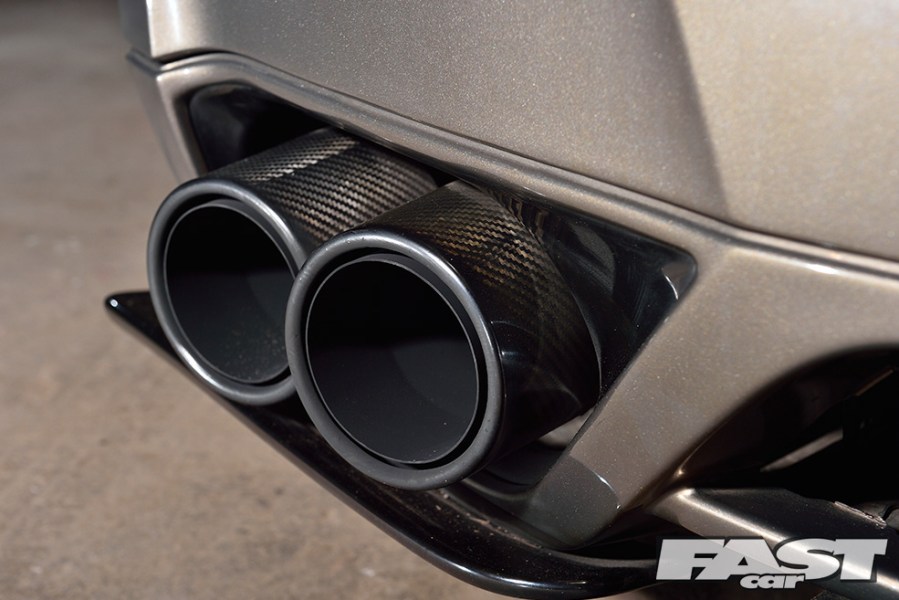
Tailpipes
Nowadays many modern cars have a distinctive tailpipe designed to fit in a specific-shape bumper recess. More often than not, the aftermarket sector replicates these to give a stealthily standard look, but with oodles more power. Of course, there are plenty of more traditional designs on the market too, everything from subtle inward-rolled items to monster slash-cut jobs. Scorpion even do some super-trick (not to mention FC Award-winning) ceramic coated ones for various fitments too.
It’s not just the exhaust bore or the amount of silencers in the system that changes the note of your exhaust, the tailpipe design is pretty important too. Generally speaking, larger pipes give more noise, and that also makes it worth considering where you point ‘em. Think of it like a trumpet sticking out of the back of your car; choose your style with your ears, as well as your eyes!
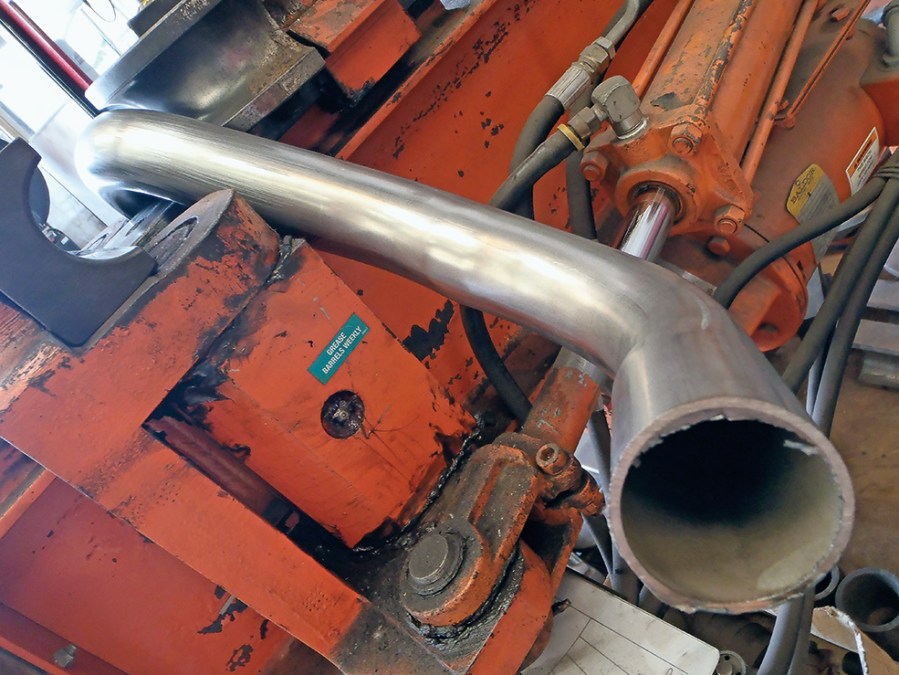
Port Smoothing
To be honest, an aftermarket tubular manifold is more of a Stage 2 tuning mod, and if your budget doesn’t stretch that far, there’s no harm in whipping off your standard item and grinding out any imperfections in the ports. De-burring and polishing anything that disturbs the airflow can be a top budget mod, and a couple of hours on the bench could give you the edge. Don’t go too mad with the grinder though! It’s always best to get professional advice first – it’s easy to go too far!

How much power can you achieve from an aftermarket car exhaust?
As with any kind of tuning, you have to be realistic with the power hike you’re expecting to see. In performance terms, an aftermarket exhaust is only as good as the restrictions it removes. It’s also good to consider the car you’re modding in the first place – an aftermarket system might make your Merc sound like an F1 car, but it doesn’t mean you’ll be beating every Ferrari off the lights.
Finally, there’s only so much an exhaust can do by itself. Engine tuning is all about the right mods working in orchestrated harmony – you’ll always benefit from some good induction, and a remap to make the most of the revised setup.

